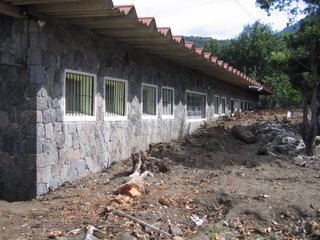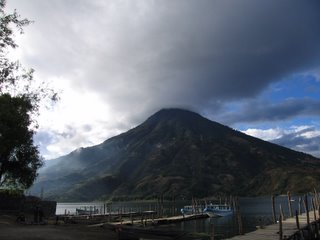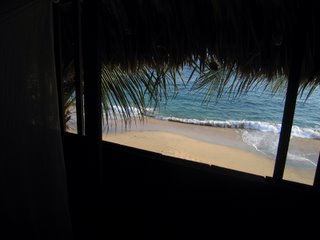Santiago Atitlan
We've spent the last week in Santiago Atitlan, one of the most tradional villages that lies on the shores of Lake Atitlan in the center of the highlands. It's inhabited by T'utzuhil Maya, whose women tradionally wear a red cloth wrapped in a halo around their head, along with the tradional skirt, handwoven with amazing patterns; the belt, hand embroidered; and the huipil, the woven and embroidered blouse. It's an incredibly beautiful area of the country, the lake is huge and surrounded by three volcanoes, the tallest reaching around 12,000 feet. Gliding across the lake in an 8 passenger boat with the water stretched out on all sides feels like sailing on the navel of the world. From all sides mountains rise steeply from the water, most of them cultivated with corn as far as 4,000 feet up the sides. On every side we could see the tan trails of mud where the earth has collapsed and fallen into the lake, some of them from this year's hurricane, some from earlier eras. We stayed in an inn owned by a friend of a friend and spent the week helping out the hospital in a town called Panabaj that was half destroyed by a mudslide. In places you can see where people have dug their houses out of the mud, their walls stained earth brown midway to the roof. From the sides of the road, many of the trees are buried in feet of mud, which has now hardened to a deep, dusty soil. Some areas are heavily coated in lime to prevent the spread of disease.
 The government has been killing stray dogs to keep them from digging up corpses. Further along, you come to a school built by a priest from the states. It can't be used for four more years, like the hospital, to ensure that any remaining bodies are decomposed. Past the hospital lies the area that has been declared a mass grave; nothing remains there but a swath of hardened mud, 150 yards across and flecked with debris from everything that lay in its path - cinderblocks painted in all the many colors that people paint their houses here; rebar, bent and twisted; cement and rock chunks; trees of all sizes broken; tools; toys and all the physical possesions that people built their lives from. This is also an area that was severely persecuted by the government from the 1970s all the way into the '90s, so in essence many people had probably just begun to live their life again when everything was swept away from them. The gyst of the persecution in Guatemala revolves around the government helping the land owners force the indiginous people off the land they had cultivated for hundreds, errr, thousands, of years. The government brutally tortured and killed more than 60,000 people. Of course, the US couldn't help but get mixed up in the interests of the land owners (being that they were the ones exporting bananas and such) so the US supported the leadership, aka, coups, of dictators who only worsened the situation. There's such a lot of sadness permeating this land, yet the people are open, friendly and beautiful. Our volunteering consisted of moving supplies from the excavated hospital in the mudslide to another hospital that will be able to use them. Our efforts felt pretty small in the large scheme but at the same time it feels good to have done something. Overall I feel helpless and guilty in the face of all the loss and devestation that the Maya people have suffered (and the poor ladinos as well). I
The government has been killing stray dogs to keep them from digging up corpses. Further along, you come to a school built by a priest from the states. It can't be used for four more years, like the hospital, to ensure that any remaining bodies are decomposed. Past the hospital lies the area that has been declared a mass grave; nothing remains there but a swath of hardened mud, 150 yards across and flecked with debris from everything that lay in its path - cinderblocks painted in all the many colors that people paint their houses here; rebar, bent and twisted; cement and rock chunks; trees of all sizes broken; tools; toys and all the physical possesions that people built their lives from. This is also an area that was severely persecuted by the government from the 1970s all the way into the '90s, so in essence many people had probably just begun to live their life again when everything was swept away from them. The gyst of the persecution in Guatemala revolves around the government helping the land owners force the indiginous people off the land they had cultivated for hundreds, errr, thousands, of years. The government brutally tortured and killed more than 60,000 people. Of course, the US couldn't help but get mixed up in the interests of the land owners (being that they were the ones exporting bananas and such) so the US supported the leadership, aka, coups, of dictators who only worsened the situation. There's such a lot of sadness permeating this land, yet the people are open, friendly and beautiful. Our volunteering consisted of moving supplies from the excavated hospital in the mudslide to another hospital that will be able to use them. Our efforts felt pretty small in the large scheme but at the same time it feels good to have done something. Overall I feel helpless and guilty in the face of all the loss and devestation that the Maya people have suffered (and the poor ladinos as well). I  want to give everything I have, yet I keep it and keep on traveling. I don't know how I can ever allow myself to feel bad about what I have and what I am doing in my life, yet somehow I'm rarely satisfied. I'm rich and lucky and free beyond belief, and so are most of the people living in the US; in New York I didn't have this perspective. Earlier today I thought that I wasn't getting anything out of traveling right now; I think maybe my problem is more that I'm getting too much out of traveling to synthesize it all at once. May I take this sadness and build it into my perspective on my own life; may I not feel guilty for what I have while at the same time wishing for more; and may we all feel and be blessed and rich and safe and happy and healthy in the coming year. Peace, happy new year, and happy birthday to me! (I've been singing myself happy birthday starting today and I think I'll keep it up until the second or so...)
want to give everything I have, yet I keep it and keep on traveling. I don't know how I can ever allow myself to feel bad about what I have and what I am doing in my life, yet somehow I'm rarely satisfied. I'm rich and lucky and free beyond belief, and so are most of the people living in the US; in New York I didn't have this perspective. Earlier today I thought that I wasn't getting anything out of traveling right now; I think maybe my problem is more that I'm getting too much out of traveling to synthesize it all at once. May I take this sadness and build it into my perspective on my own life; may I not feel guilty for what I have while at the same time wishing for more; and may we all feel and be blessed and rich and safe and happy and healthy in the coming year. Peace, happy new year, and happy birthday to me! (I've been singing myself happy birthday starting today and I think I'll keep it up until the second or so...)-Sarah



 This being our first chicken bus sans chickens, but very crowded, very loud, very raucous, old, brilliantly painted USA school bus. Buses, like the U6 I used to ride. But brighter. And fuller. Full of women wearing traditional Mayan garb, which is psychedlically bright, and old men, and kids, and mostly everyone has gold or silver teeth. We were going to stay on that bus which had a little layover and then continued to our destination city, which most people call Xela, the Mayan name. But our neighbor-passenger insisted it would take too long to wait for that bus to leave, so he hauled my bag off the bus, and I ran frantically after it, lost Dirk, as my pack was passed off to another guy, the conductor of the next Xela bus. My mochila was heaved on top of another chicken bus, and then I noticed everyone here is way less tranquilo than in mexico, they're all yelling, come on! come on! venga! venga! and I'm still looking for Dirk. He and his bag make it on the bus, and then we wait as it fills up three to a seat while vendors of fruit, chips, french fries in little paper cones, water, soda, fried plantains walk the length of the bus. Then we leave for a 3 hour ride up into the windy, cloudy mountians. The road is twisty, occasionally on a ridge and the drivers are crazy, passing other buses going up hill on curves, as they're stopping, and they honk at them as they go by. We got the wheel seat, so I was eating my knees for three hours while my ass fell asleep and I bonded with the window. We arrived in the terminal minverva in Xela, basically a big dusty road full of chicken buses of all hues.
This being our first chicken bus sans chickens, but very crowded, very loud, very raucous, old, brilliantly painted USA school bus. Buses, like the U6 I used to ride. But brighter. And fuller. Full of women wearing traditional Mayan garb, which is psychedlically bright, and old men, and kids, and mostly everyone has gold or silver teeth. We were going to stay on that bus which had a little layover and then continued to our destination city, which most people call Xela, the Mayan name. But our neighbor-passenger insisted it would take too long to wait for that bus to leave, so he hauled my bag off the bus, and I ran frantically after it, lost Dirk, as my pack was passed off to another guy, the conductor of the next Xela bus. My mochila was heaved on top of another chicken bus, and then I noticed everyone here is way less tranquilo than in mexico, they're all yelling, come on! come on! venga! venga! and I'm still looking for Dirk. He and his bag make it on the bus, and then we wait as it fills up three to a seat while vendors of fruit, chips, french fries in little paper cones, water, soda, fried plantains walk the length of the bus. Then we leave for a 3 hour ride up into the windy, cloudy mountians. The road is twisty, occasionally on a ridge and the drivers are crazy, passing other buses going up hill on curves, as they're stopping, and they honk at them as they go by. We got the wheel seat, so I was eating my knees for three hours while my ass fell asleep and I bonded with the window. We arrived in the terminal minverva in Xela, basically a big dusty road full of chicken buses of all hues. 



